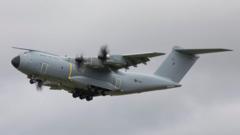Is Tesla's Robotaxi Launch in Texas the Next Big Thing?

Tesla's Robotaxi Launch: A New Era in Autonomous Transportation
On Sunday, Tesla made headlines with the rollout of its long-anticipated robotaxis in Austin, Texas. This event marks a significant milestone in Tesla's journey toward revolutionizing the transportation industry. A select group of analysts, influencers, and shareholders were invited to experience paid rides in the new autonomous vehicles, albeit with human safety operators present in the passenger seat. As Tesla positions itself to compete with existing self-driving taxi services in the United States and China, the implications of this launch are profound.
The Significance of the Robotaxi Launch
The launch of Tesla's robotaxi service is not merely a technological advancement; it reflects the company's ambition to dominate the burgeoning autonomous taxi market. Analysts have described the initial rollout as a "low-key affair," indicating that Tesla is taking a cautious approach, prioritizing safety while testing the capabilities of its autonomous driving technology. The initial fleet, featuring existing Tesla models with a small "robotaxi" logo, operates in a limited area of Austin, emphasizing a controlled and gradual introduction to the public.
Competitive Landscape
Tesla's entry into the robotaxi market comes at a time when established companies like Waymo and Zoox are already offering self-driving taxi services in major cities such as Austin, San Francisco, and Phoenix. Uber, too, is advancing its autonomous ride-hailing initiatives, recently announcing plans to accelerate trials in the UK in partnership with Chinese firms like Pony.AI and WeRide. In this competitive landscape, Tesla's strategy hinges on leveraging its extensive data from millions of vehicles on the road and its cost-effective camera-based self-driving technology.
Challenges Ahead for Tesla's Robotaxi
While Tesla's robotaxi rollout is a step forward, it faces several challenges that could impact its success. Analysts highlight the importance of Tesla's Full Self-Driving (FSD) system, which has been under scrutiny by US auto regulators and has drawn criticism from customers regarding safety and efficacy. The FSD system must demonstrate significant advancements over existing driver assistance technologies to reassure consumers and regulators alike.
Safety Concerns and Regulatory Scrutiny
Safety remains a primary concern in the deployment of autonomous vehicles. Tesla has stated that its robotaxi service will enhance safety for vulnerable road users, such as pedestrians and cyclists. However, the US National Highway Traffic Safety Administration is currently reviewing Tesla's information regarding the safety of its self-driving taxis, particularly in adverse weather conditions. The scrutiny surrounding FSD and its performance has led to heightened expectations for Tesla to deliver a reliable and safe autonomous driving experience.
Tesla's Vision for the Future
Elon Musk, CEO of Tesla, has expressed optimism about the company's technological advancements, crediting the AI and chip design teams for their contributions to the robotaxi project. Musk has noted that the robotaxi initiative is the culmination of a decade's worth of hard work, underscoring Tesla's commitment to innovation in autonomous driving technology. Looking ahead, Tesla envisions a future where its robotaxis will be a common sight on roads, transforming urban transportation.
Market Potential for Autonomous Ride-Hailing
The market for driverless taxis is poised for substantial growth, with estimates suggesting it could reach €450 billion by 2035. As more companies explore the possibilities of autonomous transportation, the competition will intensify. Tesla must navigate this landscape carefully, balancing innovation with safety and regulatory compliance to maintain its position as a leader in the electric vehicle and autonomous driving sectors.
The Road Ahead for Tesla's Robotaxi
As Tesla embarks on this new journey with its robotaxi service, several factors will play a crucial role in determining its success. These include:
- Technological Advancements: Continuous improvements in AI and self-driving algorithms will be essential for achieving a fully autonomous experience.
- Consumer Trust: Building consumer confidence through transparent communication about safety measures and the technology behind FSD will be vital.
- Regulatory Compliance: Adhering to safety regulations and addressing any concerns raised by regulatory bodies will be crucial for long-term success.
- Market Competition: Monitoring competitor developments and adapting strategies will be necessary to stay ahead in a rapidly evolving market.
Conclusion
Tesla's robotaxi launch is a significant step toward realizing the vision of autonomous urban transportation. As the company continues to develop its technology and navigate the challenges ahead, the future of robotaxis holds the promise of transforming how we think about mobility. The balance between innovation, safety, and regulatory compliance will be pivotal in shaping Tesla's role in the autonomous vehicle landscape.
The question remains: will Tesla's robotaxi service revolutionize urban transportation as we know it, or will it face insurmountable challenges in a competitive market? Only time will tell.
Frequently Asked Questions
What is Tesla's robotaxi service?
Tesla's robotaxi service is an autonomous ride-hailing service that aims to provide safe and efficient transportation using Tesla vehicles equipped with advanced self-driving technology.
How does Tesla's robotaxi compare to other self-driving services?
Tesla's robotaxi utilizes its Full Self-Driving (FSD) technology, which aims to leverage extensive data from Tesla vehicles, while competing services like Waymo and Zoox use their proprietary systems and technology.
What are the safety measures in place for Tesla's robotaxi?
Initially, Tesla's robotaxi will feature human safety operators in the passenger seat to monitor the vehicle's performance and intervene if necessary, ensuring a layer of safety during the early phases of deployment.
What challenges does Tesla face with its robotaxi launch?
Challenges include regulatory scrutiny, consumer trust, competition from established players, and the need for continuous improvements in the Full Self-Driving system to ensure safety and reliability.
As Tesla forges ahead with its ambitious goals, how do you envision the future of transportation evolving with the advent of robotaxis? #Tesla #Robotaxi #AutonomousVehicles
Published: 2025-06-23 11:37:05 | Category: technology



